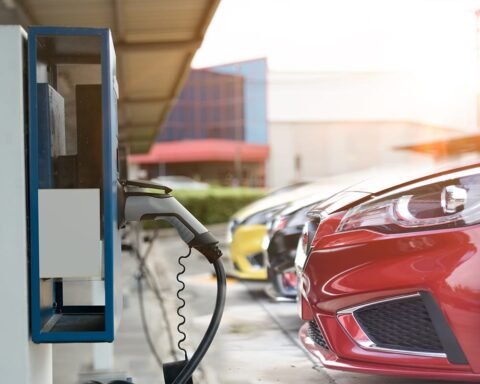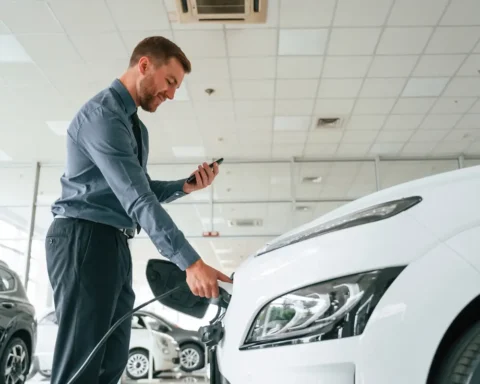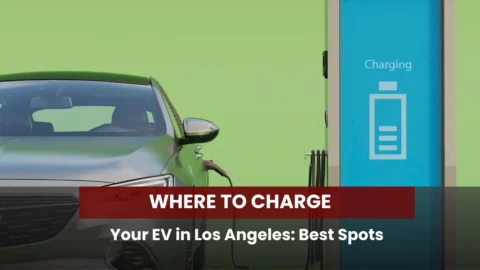Wales is famous for its breathtaking landscapes from the rugged peaks of Snowdonia to the stunning Pembrokeshire coast. But let’s be honest, it’s also famous for its rain. As a rapidly growing community of electric cars in Wales continues to embrace sustainable transport, mastering the art of driving and maintaining your EV in our often-wet climate is essential.
This Article is made for Welsh EV owners, providing practical, fact-based tips on everything from improving your electric car range in cold and wet weather to navigating the local charging infrastructure.
The EV Advantage in Wet Conditions
Most modern EVs, particularly those built on a dedicated electric platform, have their heavy battery pack located low down in the chassis. This creates a remarkably low centre of gravity, significantly improving stability and reducing body roll. This inherent stability is a huge benefit for electric vehicle safety in wet weather across the UK.
Furthermore, many EVs employ advanced traction control systems and often feature instantaneous torque delivery, managed electronically for ultimate precision. Unlike a petrol or diesel car, the motor’s power output can be finely adjusted thousands of times per second, helping to prevent wheel spin on slippery surfaces.
Essential EV Driving Tips in Rain on Welsh Roads
Driving an EV in the rain requires the same common sense as any vehicle, but with a few electric-specific nuances. The core advice remains: slow down and increase your stopping distance.
1. Mastering Regenerative Braking
Your EV’s regenerative braking system, which recovers energy when you lift off the accelerator, needs a slightly different approach in the wet.
- Smoothness is Key: While high regenerative settings are great for energy recovery, an abrupt lift of the accelerator can cause a sudden, engine-braking-like deceleration, which might feel twitchy on a slick road. When driving electric car safely in rain, it is best to lift off the accelerator gradually and smoothly to maintain traction.
- The ‘B’ Mode Balance: If you have an adjustable regeneration setting that you may want to dial it back slightly from its most aggressive setting in heavy rain, especially on winding roads in areas like the Brecon Beacons, to allow for more controlled deceleration.
2. Steering Clear of Deep Water
This is perhaps the most critical tip for any vehicle, but particularly for EVs. While an EV’s high-voltage battery pack is fully sealed, often with an IP67 or higher rating (meaning it can withstand temporary submersion), driving through deep water remains highly risky.
- The Danger of the Bow Wave: The biggest threat is not the waterproofing of the battery, but the potential for the vehicle to create a ‘bow wave’ of water that can damage other, lower-slung components or even flood the cabin.
3. Tyre Condition and Pressure
Your tyres are the single point of contact with the road. Given the frequency of rain, ensure they are in top condition.
- Pressure: The extra weight of an EV battery means correct tyre pressure is vital for even wear and optimal wet-weather grip. Always check your car manual for the correct pressure settings, particularly before a long journey. Many top manufacturers are now producing EV-specific tyres designed to handle the greater weight and instant torque, offering superior wet grip. Consider these when replacing your current set.
Navigating EV Charging Stations Wales in the Rain
A common concern for new EV owners in the UK is whether it’s safe to charge in the rain. The answer is an emphatic yes.
- Safety First: Public charging points and your home wallbox are rigorously designed and tested to be completely weatherproof. The charging process only begins when the car and the charger communicate and confirm a secure, dry connection.
- Keeping the Port Dry: While the technology is safe, as a courtesy to the equipment, wipe down the charging port cover and the plug handle with a dry cloth before connecting, especially when using rapid chargers on the motorway network.
The network of public EV charging stations Wales is expanding, with initiatives like the Welsh Government’s focus on placing rapid chargers on the Strategic Road Network to ensure you’re never far from a top-up, even in the most remote areas. Always use reliable apps like Zap-Map to check the status of chargers before setting off, especially when embarking on a scenic Wales electric car travel guide road trip.
EV Maintenance Tips for Rainy Season
A proactive approach to maintenance ensures your EV is always ready for the next Welsh downpour.
- Wiper and Screen Wash: Ensure your wiper blades are in perfect condition. Replace them if they leave streaks. Always top up your washer fluid with a high-quality screen wash to combat road spray from lorries and other vehicles.
- Brake Inspection: While regenerative braking reduces the wear on your physical brakes, it can lead to under-use, especially in the rear. Get your brake pads and discs checked regularly to ensure they remain clean and corrosion-free. When how to drive an electric car in rain, the ability to stop is paramount.
- Underbody Check: The undercarriage of an EV is heavily protected, but a yearly inspection for any damage or corrosion to the battery casing, especially after driving on rough rural roads or through large puddles, is a sensible precaution.
Choosing the Best EVs for Rainy Conditions UK
While any modern EV is safe, certain models are better suited for the diverse conditions of Wales, from the high mountain passes to the slick city streets of Cardiff or Swansea. Look for vehicles with:
- All-Wheel Drive (AWD): Models like the Tesla Model Y, Audi e-tron, and certain versions of the Kia EV6 or Hyundai IONIQ 5 offer a dual-motor setup, which vastly improves grip and stability on slippery, wet roads.
- Excellent Wet Grip Tyres: As mentioned, a good set of tyres makes a bigger difference than the car’s badge.
- High Ground Clearance: For rural users or those expecting more flood-prone areas, a higher SUV-style EV offers an extra layer of confidence when dealing with standing water.
The message is clear, whereas electric cars in Wales are not just a sustainable choice; they are a safe, stable, and practical choice for the UK’s often wet climate. By implementing these EV maintenance tips for rainy season and adjusting your driving style, you can ensure you how to drive an electric car in rain safely and get the most out of your vehicle, all year round.
Frequently Asked Questions
Yes, it is completely safe. You can confidently use any of the EV charging stations Wales network during a downpour.
Rain itself has a minor impact. The cold temperatures that often accompany the rain are the main culprit. Range can temporarily drop by up to 15-20% in very cold conditions (near freezing) compared to mild temperatures, primarily due to the energy used for cabin and battery heating. Following EV driving tips in rain, such as pre-conditioning, helps mitigate this.
Not necessarily. Aquaplaning is more related to tyre condition and speed. The instant torque can, however, cause wheel-spin more easily, which is why smooth acceleration is key for electric vehicle safety in wet weather.
It is strongly advised to never drive through moving water or standing water deeper than about 10cm (4 inches). While the battery is waterproof, driving through deeper water risks damage to other low-slung components and can lead to a loss of control. Always find an alternative route.
For the best performance, consider high-quality tyres with a good ‘A’ or ‘B’ wet grip rating on the EU tyre label. All-season tyres are an excellent choice for the UK, offering reliable performance year-round. This is one of the top ways to ensure driving electric car safely in rain.
The most effective way is to use dedicated EV mapping apps like Zap-Map or the Transport for Wales (TfW) website. These tools provide real-time location, availability, and power ratings of EV charging stations Wales, ensuring you can plan your Wales electric car travel guide route efficiently, even in remote areas.
From smart tips to maintenance must-knows, we’ve got your journey covered. Join the conversation at Ask about cars!!







